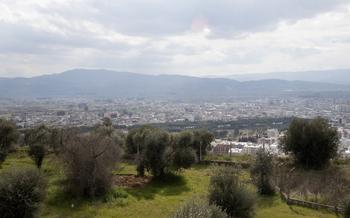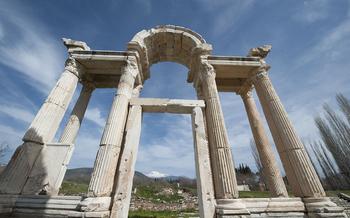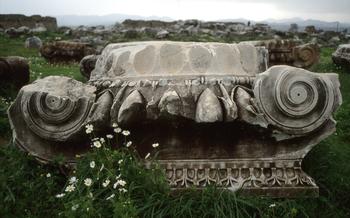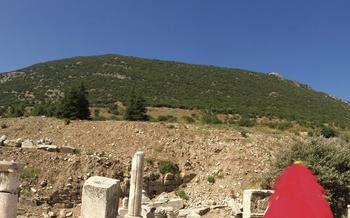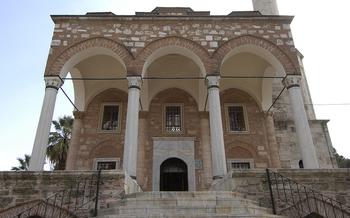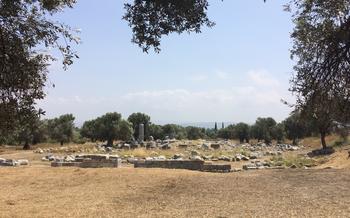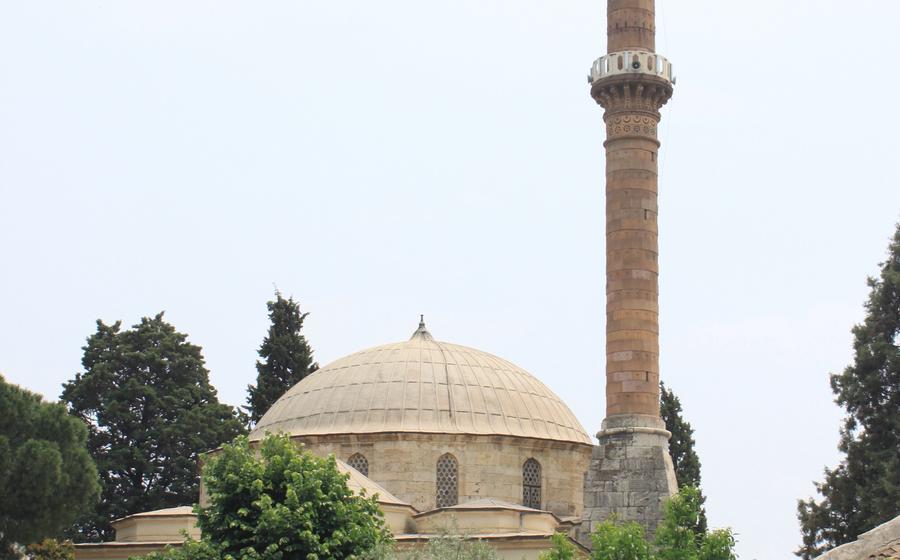
Kuşadası Amphitheatre
- The Antiquity of Kuşadası Amphitheatre
- History of the Amphitheater
- Location and Accessibility
- Architectural Features
- Acoustics and Performances
- Views and Surroundings
- Excavations and Discoveries
- Restoration and Preservation
- Visiting the Amphitheater
- Things to See and Do
- Nearby Attractions
- Cultural Events and Festivals
- Local Cuisine and Restaurants
- Accommodations and Hotels
The Antiquity of Kuşadası Amphitheatre
The Kuşadası Amphitheater stands as a testament to the region's rich historical tapestry, with its origins deeply entwined with the ancient Greek civilization. In the 3rd century BC, the city of Ephesus, a prominent Ionian metropolis, extended its influence to the surrounding areas, including Kuşadası. It was during this period that the amphitheater was constructed, serving as a central venue for entertainment and cultural events.
The amphitheater's strategic location, situated on a hill overlooking the Aegean Sea, further enhanced its significance. It became an integral part of the city's social and cultural fabric, hosting a variety of performances, including theatrical productions, musical concerts, and gladiatorial contests.
Over the centuries, the amphitheater has witnessed countless spectacles and events, mirroring the ebb and flow of history. It has endured invasions, earthquakes, and the passage of time, yet its grandeur and majesty remain undiminished, captivating visitors with its timeless allure.
Today, the Kuşadası Amphitheater stands as one of Turkey's most renowned historical sites, drawing throngs of visitors from around the world. It serves as a vivid reminder of the region's rich cultural heritage and the enduring legacy of ancient Greek civilization.
History of the Amphitheater
The Kuşadası Amphitheater is a magnificent testament to the ancient Greek civilization's architectural prowess and cultural significance. Constructed in the 2nd century AD during the Roman Empire, it played a pivotal role as a venue for various entertainments and public events. The amphitheater's design and layout reflect the influence of Hellenistic and Roman architectural styles, showcasing a combination of functionality and grandeur.
With a seating capacity of approximately 20,000 spectators, it ranks among the largest amphitheaters in Turkey, highlighting its importance as a regional center for entertainment and cultural expression. The amphitheater's design features a central arena, surrounded by tiers of seating arranged in a horseshoe-like formation. The stage area, known as the orchestra, provided a versatile space for theatrical performances, gladiator contests, and other spectacles.
The amphitheater's construction showcases the advanced engineering and architectural techniques of the ancient Greeks and Romans. Built using local stone, the structure exhibits remarkable precision and attention to detail, ensuring excellent acoustics and visibility from all seating areas. These features contributed to the amphitheater's success as a venue for dramatic performances, where actors could deliver their lines with clarity and impact.
The Kuşadası Amphitheater stands as a testament to the enduring legacy of ancient Greek theater and entertainment. Its historical significance and architectural grandeur make it a must-visit destination for anyone interested in exploring the rich cultural heritage of Turkey.
Location and Accessibility
The Kuşadası Amphitheater is situated in the heart of Kuşadası, a picturesque coastal town in the Aydın province of Turkey. It is located on a hillside overlooking the Aegean Sea, offering breathtaking views of the turquoise waters and the surrounding landscape. Reaching the amphitheater is a breeze, with convenient transportation options available. Visitors can take advantage of the local bus network, which provides direct routes to the site. Alternatively, they can opt for a scenic taxi ride or rent a car to explore the region at their own pace. Ample parking is available near the amphitheater, ensuring a hassle-free visit for those arriving by car. The site is also easily accessible for visitors with disabilities, with designated parking spaces and wheelchair-friendly pathways.
Architectural Features
The Kuşadası Amphitheatre showcases a remarkable blend of architectural finesse and functionality. Constructed using locally sourced marble and limestone, the amphitheater exhibits exceptional craftsmanship and attention to detail. Its imposing facade features a series of arched entrances, intricate carvings, and decorative friezes that depict scenes from Greek mythology and everyday life. The seating arrangements comprise concentric tiers of stone benches, divided into sections by imposing staircases. The tiers rise steeply from the orchestra, ensuring optimal sightlines and acoustics for spectators. The stage area, once adorned with elaborate stage sets, displays remnants of intricate mosaic floors and niches for statues. Despite the passage of time and natural elements, the amphitheater's architectural integrity remains remarkably well-preserved, offering a glimpse into the grandeur and artistry of ancient Greek construction.
Acoustics and Performances
The Kuşadası Amphitheater is renowned for its exceptional acoustics, which were crucial in ancient Greek theater. The amphitheater's design and construction were carefully planned to ensure that sound carried clearly throughout the entire seating area, allowing every spectator to fully experience the performances. The curved tiers created a natural reverberation effect, while the stage's shape and materials helped to project sound towards the audience.
In ancient times, the amphitheater hosted a variety of performances beyond plays. Musical concerts, poetry recitals, and even gladiatorial contests were held within its walls. The amphitheater's acoustics were particularly important for musical performances, as they allowed the subtle nuances of instruments and voices to be heard clearly.
Today, the amphitheater continues to host a variety of performances, including plays, concerts, and cultural events. The exceptional acoustics make it a popular venue for musicians and performers from around the world. Visitors can experience the magic of the ancient Greek theater by attending one of the many performances held throughout the year.
Views and Surroundings
Perched on a hillside overlooking the azure waters of the Aegean Sea, the Kuşadası Amphitheater offers breathtaking views that transport visitors to another era. The panoramic vistas from the amphitheater's upper tiers are simply stunning. Gazing out across the landscape, one can admire the shimmering sea, the verdant mountains, and the distant historical sites that dot the horizon. The amphitheater's unique location provides a perfect vantage point to appreciate the natural beauty and rich history of the region.
The amphitheater's integration with its surroundings is remarkable. It seems to blend seamlessly into the landscape, as if it were carved out of the very hillside on which it stands. The surrounding natural beauty enhances the amphitheater's aesthetic appeal and creates a truly immersive experience for visitors. The Aegean Sea, with its ever-changing hues of blue, provides a stunning backdrop for performances and events held at the amphitheater. The picturesque mountains add depth and dimension to the scenery, while the nearby historical sites serve as reminders of the region's rich past.
Whether it's the panoramic views of the sea, the verdant mountains, or the nearby historical sites, the Kuşadası Amphitheater offers a visual feast for visitors. The combination of natural beauty and historical significance creates a truly unforgettable experience for all who visit this ancient wonder.
Excavations and Discoveries
The Kuşadası Amphitheater has undergone extensive excavations and research over the years, revealing significant discoveries that have shed light on its past. Archaeologists have unearthed numerous artifacts, including pottery fragments, coins, inscriptions, and remnants of ancient structures. These discoveries have provided valuable insights into the daily lives and customs of the people who inhabited the region during antiquity. Ongoing archaeological projects continue to uncover new information, contributing to our understanding of ancient Greek culture and history. Excavations have also revealed several underground chambers and tunnels beneath the amphitheater, believed to have been used for storage or as dressing rooms for performers. These discoveries have provided a glimpse into the behind-the-scenes operations of the amphitheater and the lives of those who worked there.
Restoration and Preservation
The Kuşadası Amphitheater has undergone extensive restoration and preservation efforts over the years to maintain its historical integrity and authenticity. The restoration process involved careful cleaning, repair, and reconstruction of damaged elements, using traditional techniques and materials to ensure the amphitheater's original character is preserved.
One of the main challenges faced during the restoration was the need to balance the preservation of the amphitheater's ancient features with the requirements for modern-day use. This included ensuring the safety and accessibility of the site for visitors while minimizing any impact on the original structure.
The restoration efforts also focused on preserving the amphitheater's unique acoustics, which played a crucial role in ancient Greek theater. Careful attention was paid to maintaining the original seating arrangements, stage design, and architectural features that contribute to the amphitheater's exceptional sound quality.
The ongoing work to restore and preserve the Kuşadası Amphitheater is essential for safeguarding this valuable historical site for future generations. Through these efforts, the amphitheater remains a living testament to ancient Greek culture and a symbol of the region's rich history and heritage.
Visiting the Amphitheater
For those planning to visit the Kuşadası Amphitheater, it is important to consider the practicalities of the visit. The amphitheater is open to the public daily, with operating hours typically from 8:00 AM to 6:00 PM. Admission fees are reasonable, allowing visitors to access this historical site at an affordable price.
To fully appreciate the amphitheater's grandeur and significance, guided tours are highly recommended. These tours provide valuable insights into the history, architecture, and performances that once took place within its walls. Audio guides are also available for visitors who prefer a self-guided exploration.
The best time to visit the amphitheater is during the shoulder seasons (spring and autumn) when the weather is pleasant, and the crowds are smaller. This allows visitors to enjoy a more intimate and immersive experience without the hustle and bustle of peak tourist season.
For visitors with disabilities, the amphitheater is equipped with accessible features such as ramps and designated seating areas. Additionally, informational materials and signage are available in multiple languages to enhance the visitor experience for all.
Things to See and Do
Within the amphitheater, visitors can explore various interactive exhibits and displays that provide insights into ancient Greek theater, history, and culture. These exhibits showcase artifacts, replicas, and multimedia presentations that bring the past to life. Educational programs and workshops are also offered, allowing visitors to learn about the techniques and practices of ancient Greek theater.
The amphitheater also features a gift shop and souvenir stands where visitors can purchase mementos of their visit. Local crafts and handmade souvenirs are available, providing an opportunity to support local artisans and take home a piece of Turkish culture.
Nearby Attractions
The Kuşadası Amphitheater is situated in a region brimming with historical and cultural treasures. A short distance away lies the ancient city of Ephesus, renowned for its remarkably preserved ruins. Visitors can marvel at the grandeur of the Temple of Artemis, one of the Seven Wonders of the Ancient World, and explore the well-preserved streets, theaters, and libraries of this once-thriving metropolis. Another must-see destination is the House of Virgin Mary, believed to be the final resting place of the mother of Jesus Christ. This modest stone house offers a serene and spiritual experience, attracting pilgrims and visitors from around the world. For those seeking a deeper connection with ancient Greek mythology, the Temple of Artemis, dedicated to the goddess of hunting, nature, and childbirth, stands as a testament to the region's rich history. These nearby attractions provide a comprehensive exploration of the region's ancient past, allowing visitors to immerse themselves in the rich tapestry of history that surrounds the Kuşadası Amphitheater.
Cultural Events and Festivals
The Kuşadası Amphitheater is not merely a historical site but also a vibrant cultural hub that hosts a variety of events and festivals throughout the year. These events aim to preserve and promote ancient Greek traditions and culture, offering visitors a unique opportunity to experience live performances, concerts, and theatrical productions in an authentic setting.
One of the most notable events is the annual Kuşadası Amphitheater Festival, which takes place during the summer months. This festival showcases a diverse range of performances, including classical Greek plays, modern dance productions, and international music concerts. Visitors can immerse themselves in the magic of ancient Greek theater as they witness talented actors bring to life the works of Sophocles, Euripides, and other renowned playwrights.
In addition to the Amphitheater Festival, the site also hosts smaller-scale events and performances throughout the year. Visitors can enjoy traditional Turkish music concerts, dance recitals, and even film screenings under the stars. These events provide a unique blend of ancient and modern culture, allowing visitors to experience the rich artistic heritage of the region.
To make the most of your visit, it's advisable to check the official website of the Kuşadası Amphitheater or contact the local tourism office for the latest event schedules and ticket information. Plan your trip accordingly to coincide with a festival or performance that interests you and enjoy an unforgettable cultural experience in this historic setting.
Local Cuisine and Restaurants
After a captivating journey through history at the Kuşadası Amphitheater, tantalize your taste buds with the delectable flavors of traditional Turkish cuisine. The region boasts an array of culinary delights that will leave you craving for more. Indulge in the freshness of seafood caught straight from the Aegean Sea, savoring the succulent flavors of grilled fish, aromatic shrimp, and mouthwatering calamari. For a taste of local specialties, try "gözleme," a savory pastry filled with cheese, spinach, or minced meat, or "köfte," succulent meatballs grilled to perfection. Don't miss the opportunity to experience the sweetness of Turkish desserts, such as flaky börek, syrupy güllaç, and creamy künefe, a delightful blend of shredded filo dough, nuts, and cheese. Vegetarian and vegan options are readily available, ensuring that every visitor can embark on a culinary adventure.
Accommodations and Hotels
For a comfortable and convenient stay, consider the variety of accommodation options available near the Kuşadası Amphitheatre. Choose from cozy guesthouses, charming boutique hotels, or modern resorts to suit your budget and preferences. Immerse yourself in the local culture by opting for a traditional Turkish homestay, where you'll experience warm hospitality and authentic Turkish cuisine. Whether you seek a serene retreat or a lively hub, there's an accommodation to match your style, just steps away from the amphitheater and other attractions.
